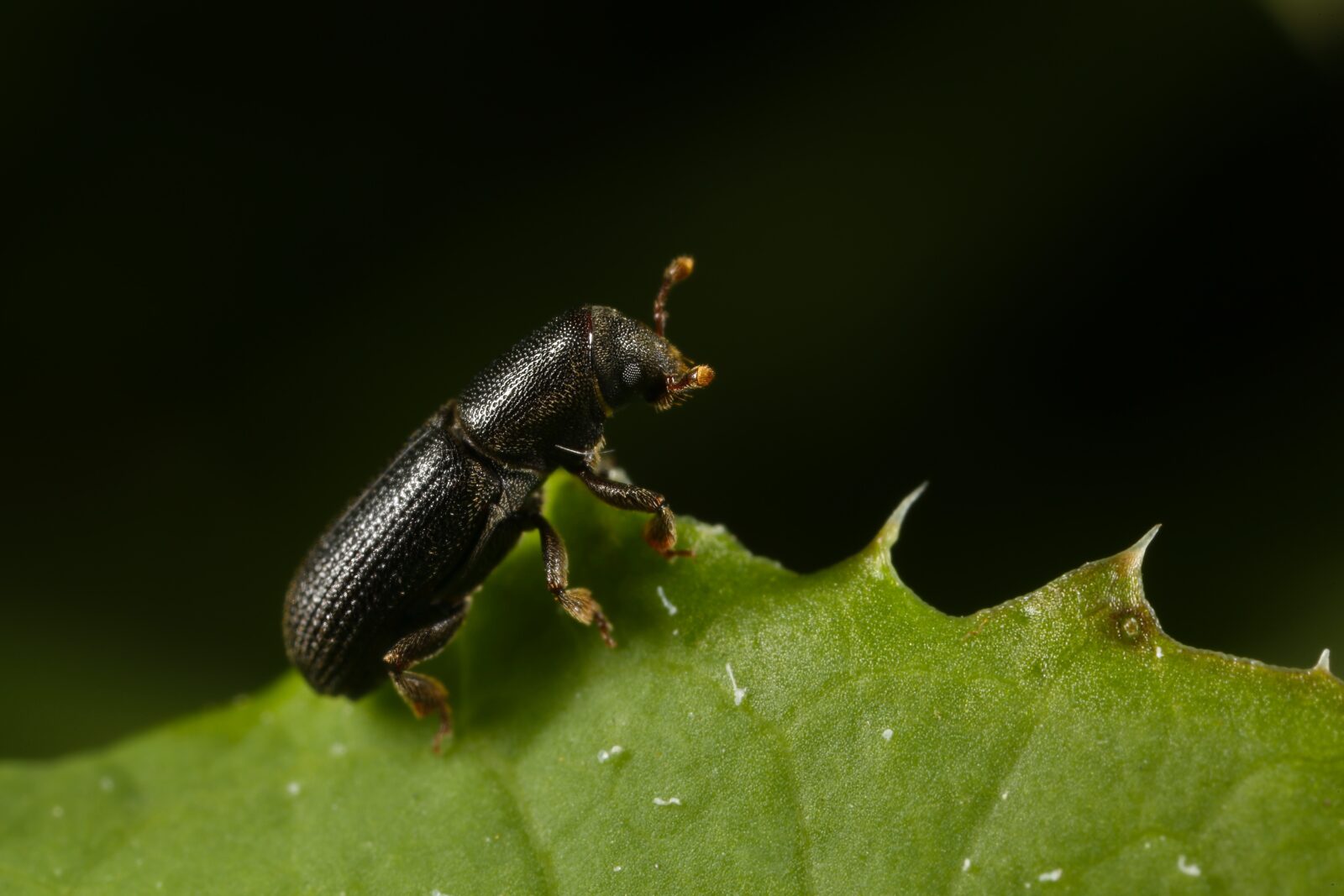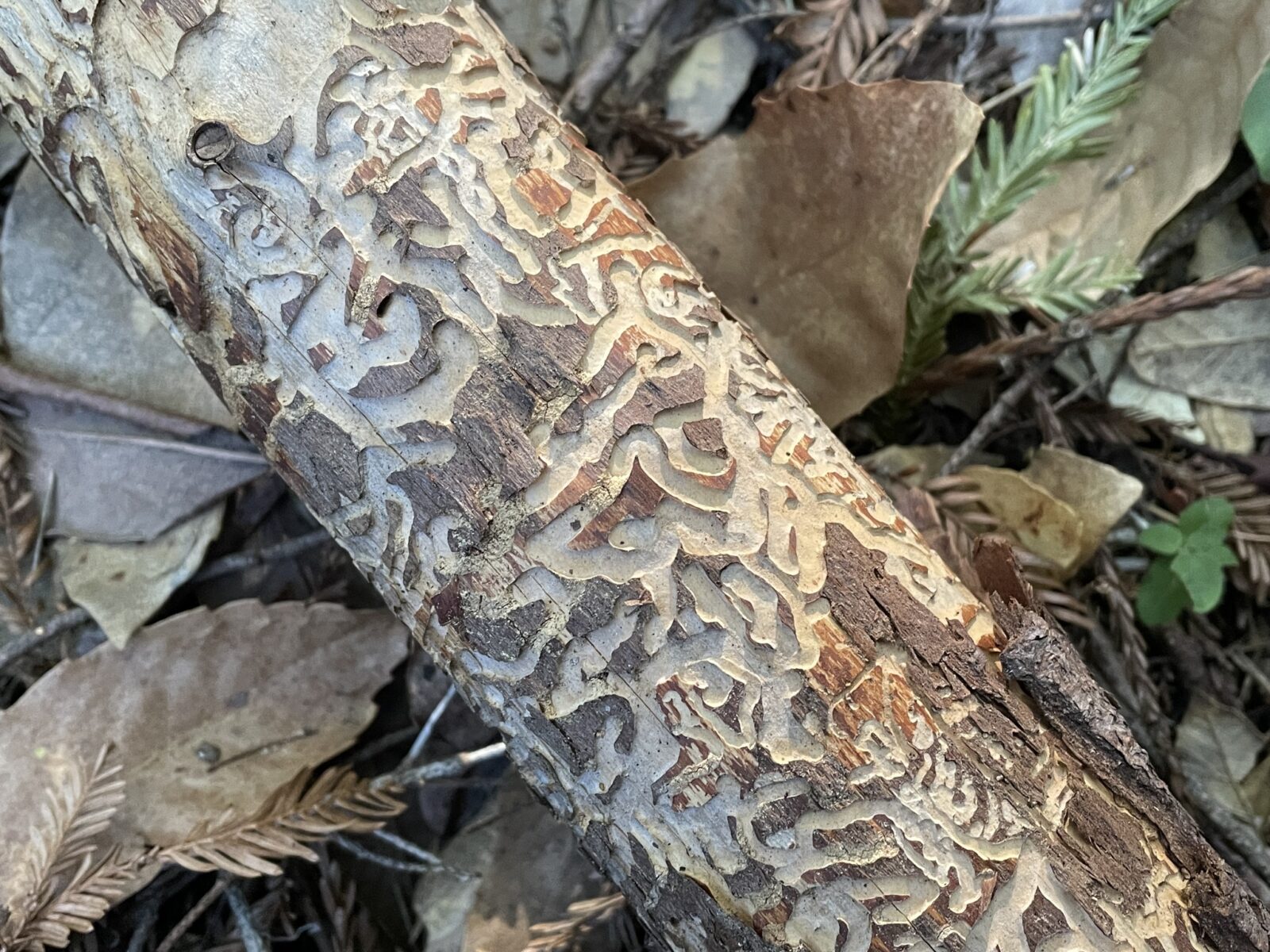While walking in the woods, you’ve likely encountered a dead log engraved with maze-like squiggles. They may look like magical inscriptions in a secret forest spellbook, but these natural carvings are known as beetle galleries, and the grooves are munched out by the larvae of bark beetles in the subfamily Scolytinae.
“We actually identify bark beetle species based on the gallery pattern,” says Crystal Homicz, a forest entomology PhD candidate at UC Davis. Galleries can be shaped like wings, tuning forks, or the letter E. The native (and very destructive) western pine beetle carves a telltale spaghetti-like squiggle, which researchers call “spaghetti western.” Over 200 different species of bark beetles live in California, most of them native.
Bark beetles get a bad rap because when their larvae nibble all the way around a tree’s inner bark, they cut off its ability to shuttle water and nutrients, and the tree withers and dies. These beetles (at least the native species) are just the last straw—they usually only infest frail, diseased, or already dead trees. But even healthy trees become susceptible when stressed by drought, wildfire, or overcrowding. During the 2014-2017 drought, bark beetles killed over 100 million trees in California, and over the past three decades, more trees in the western U.S. were killed by beetles than by wildfire.
“The size of outbreaks we’ve seen is really just unprecedented,” says Homicz. Scientists use galleries to piece together the histories of beetle outbreaks—and they emphasize that the beetles are not to blame. “People over-demonize bark beetles,” says Homicz. “They’re native here. The forest, when it’s healthy, is adapted to these beetles.”
Over millions of years, bark beetles have adapted to sniff out stressed trees from miles away. That sharp smell we know and love as “piny” comes from a stress chemical called alpha-pinene, among others, which female bark beetles hone in on to find vulnerable trees. A healthy tree fends off the burrowing beetle by pushing it back out of its own hole with a pulse of pitchy, toxic sap.
But when a drought-stricken or otherwise stressed tree can’t muster that defensive sap, the mother beetle will release pheromones to summon all her friends, triggering a mass infestation to overwhelm the tree’s defenses. Then, she will drill into its tender inner bark, laying her eggs underneath. When the larvae hatch, they chew their way through the wood, leaving grooves packed with sawdust-like frass in their wake. Ambrosia bark beetles take a different tack: they farm symbiotic fungi, which break down the tree tissue for them, and then the beetles eat the fungi.
An infested tree can potentially become fodder for thousands of larvae. When weakened trees are packed together, the beetle population can explode and overwhelm even healthy trees through sheer numbers, triggering landscape-level mass die-offs. Trees stressed by wildfire make prime targets for a particular beetle phylum—Melanophila, the fire chaser beetles. They use infrared-sensing organs in their thoraxes to make a beeline for blazes and lay eggs in the smoldering forest.

Some scorn bark beetles as destructive pests and tree-killers, but they also help maintain healthy forests. Bark beetles cull dead and dying trees and break them down, which thins crowded groves and recycles nutrients. Woodpeckers and other birds rely on them for food, pecking tidy rows of holes in tree bark in search of larval feasts. A greater variety of healthier, less crowded trees makes the forest more resilient to future stressors.
“These are native insects that play an important role in the forest’s health and ecosystem,” says Michael Jones, a UC cooperative extension forest advisor. “They’re not the main cause of tree decline or mortality.” Flawed forestry management, fire suppression, and climate change are more to blame than the beetles that deliver the finishing blow, he says.
Next time you spot a fallen log, take a moment to check for meandering grooves—spaghetti western or otherwise—that scribe the tale of tiny beetle lives and towering tree deaths beneath the bark.





